2019-2020学年高一英语人教版(2019)必修一Welcome Unit Discovering Useful Structures课件(40张PPT)
文档属性
| 名称 | 2019-2020学年高一英语人教版(2019)必修一Welcome Unit Discovering Useful Structures课件(40张PPT) |  | |
| 格式 | zip | ||
| 文件大小 | 68.0KB | ||
| 资源类型 | 教案 | ||
| 版本资源 | 人教版(2019) | ||
| 科目 | 英语 | ||
| 更新时间 | 2019-10-10 10:08:10 | ||
图片预览

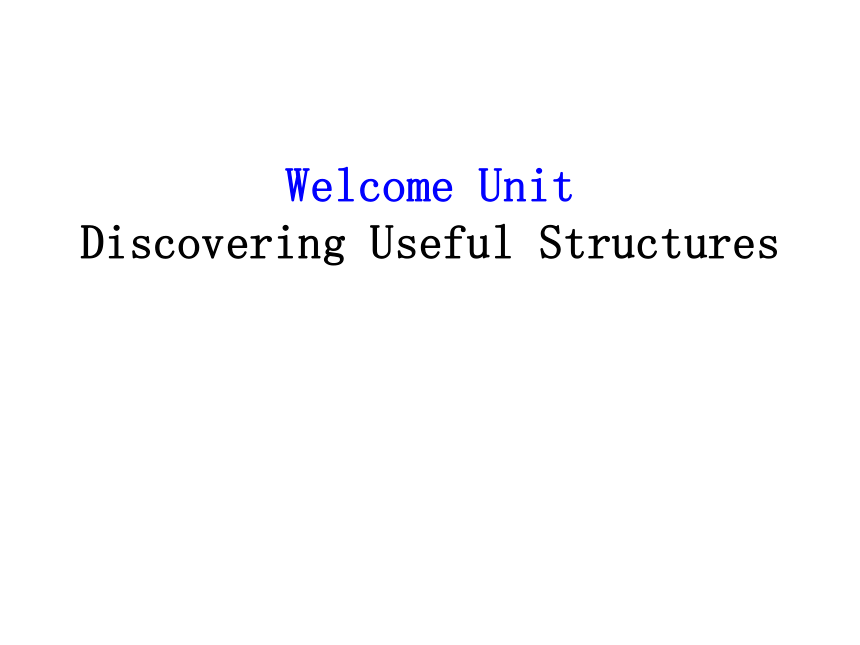
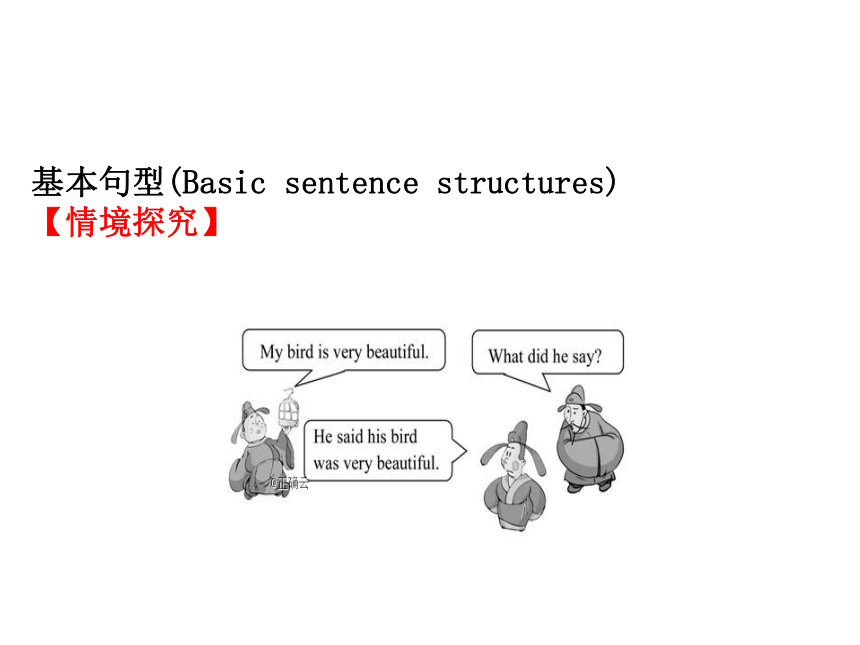
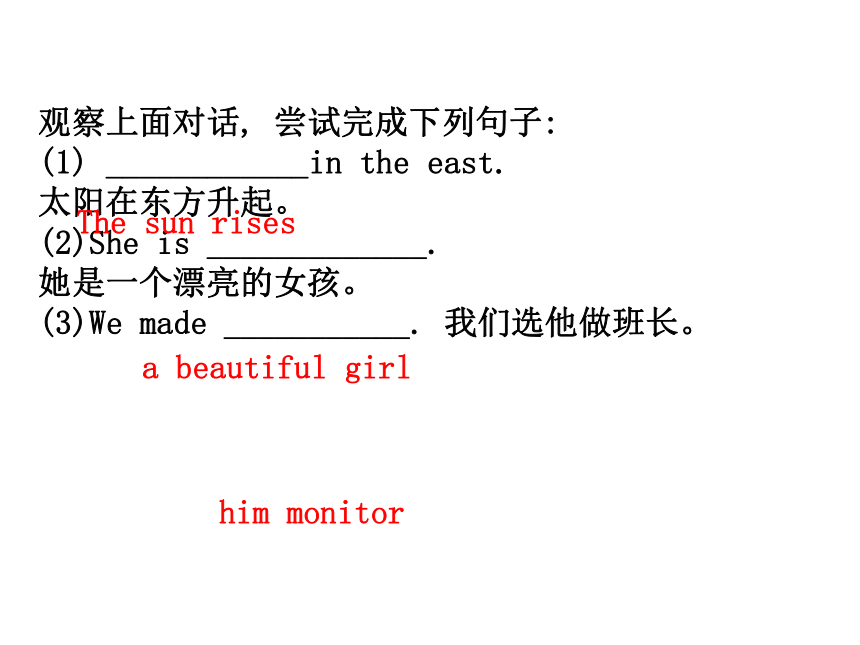
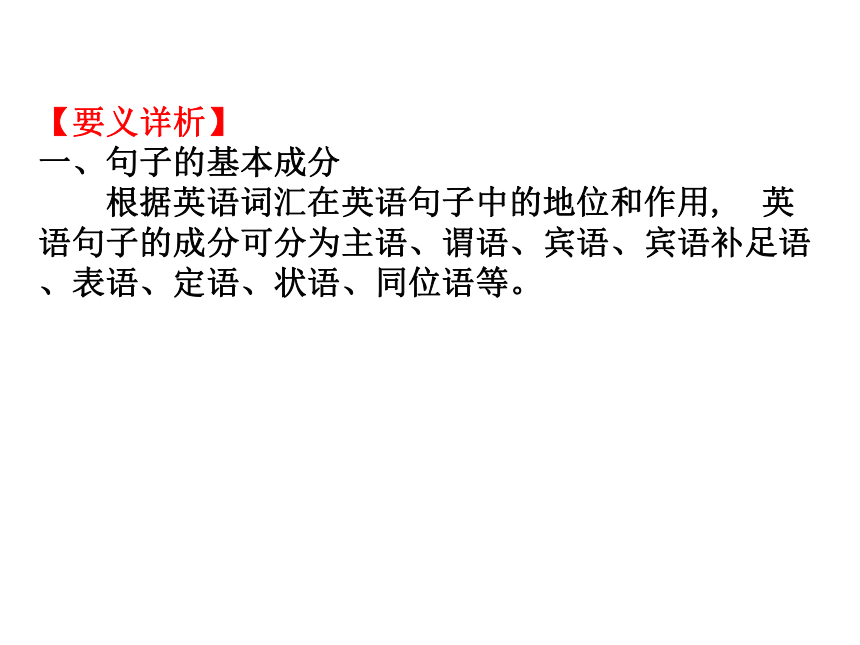
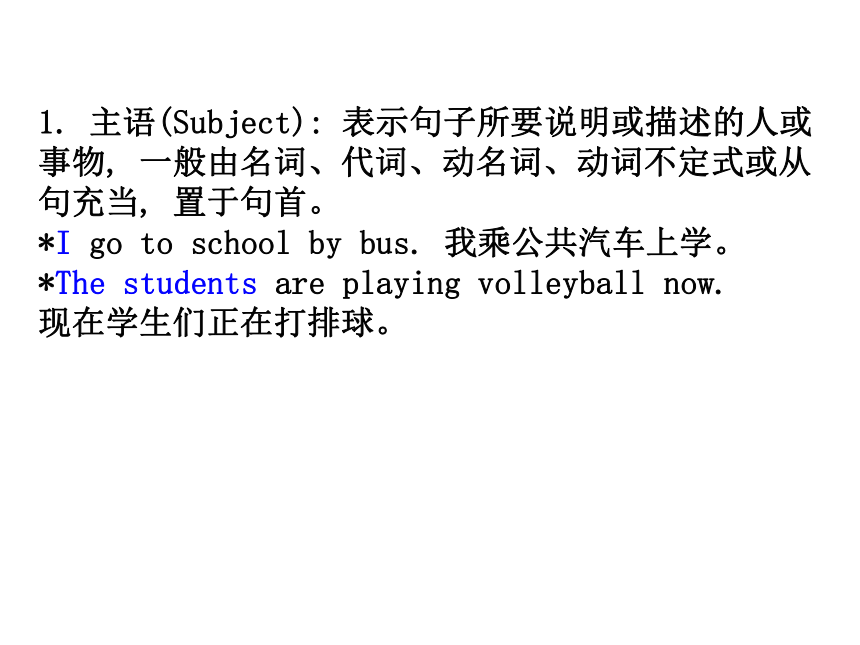
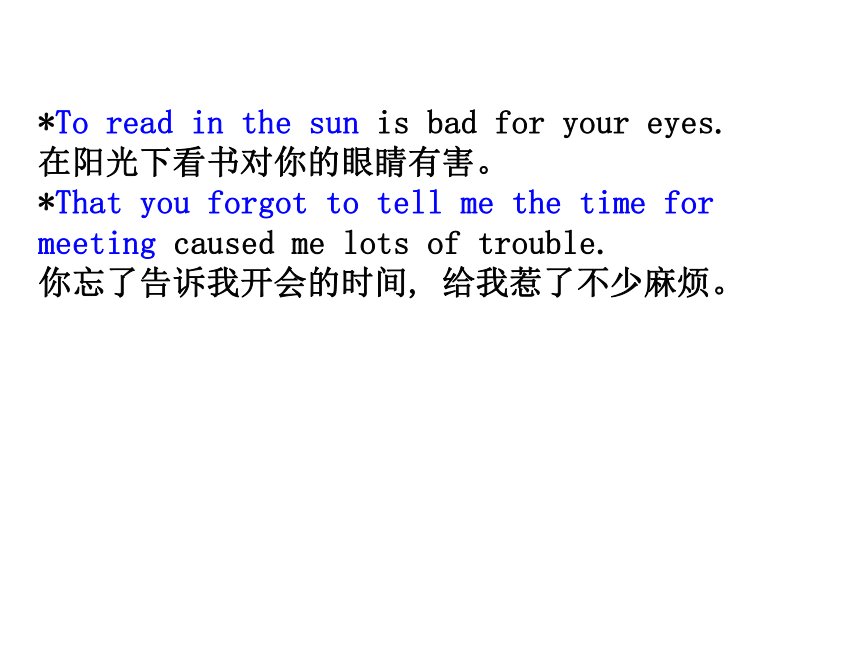
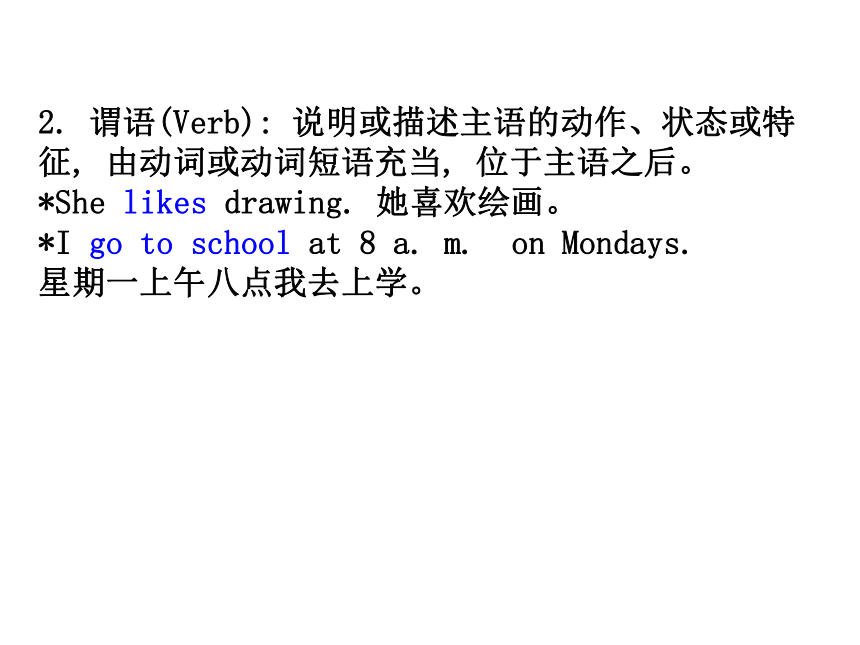
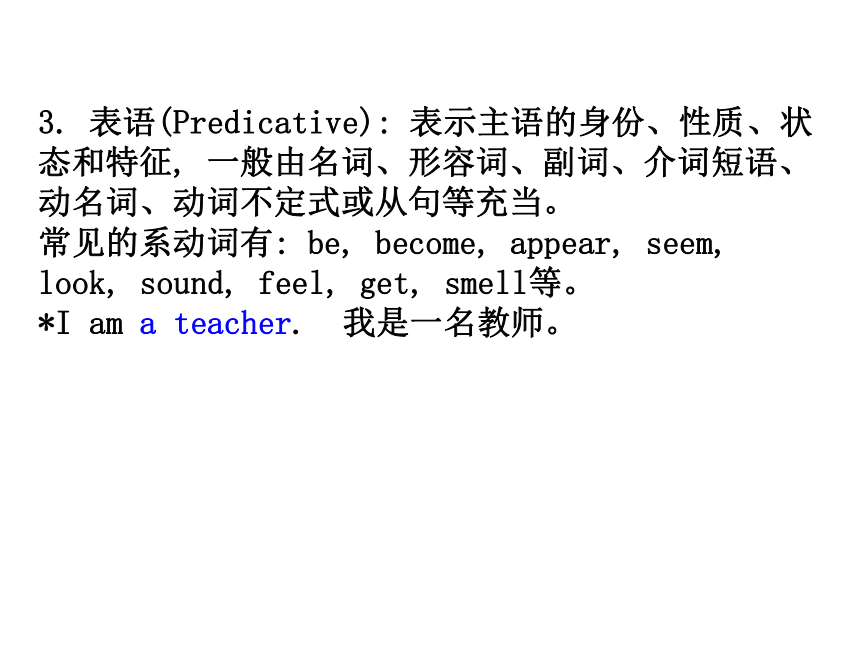
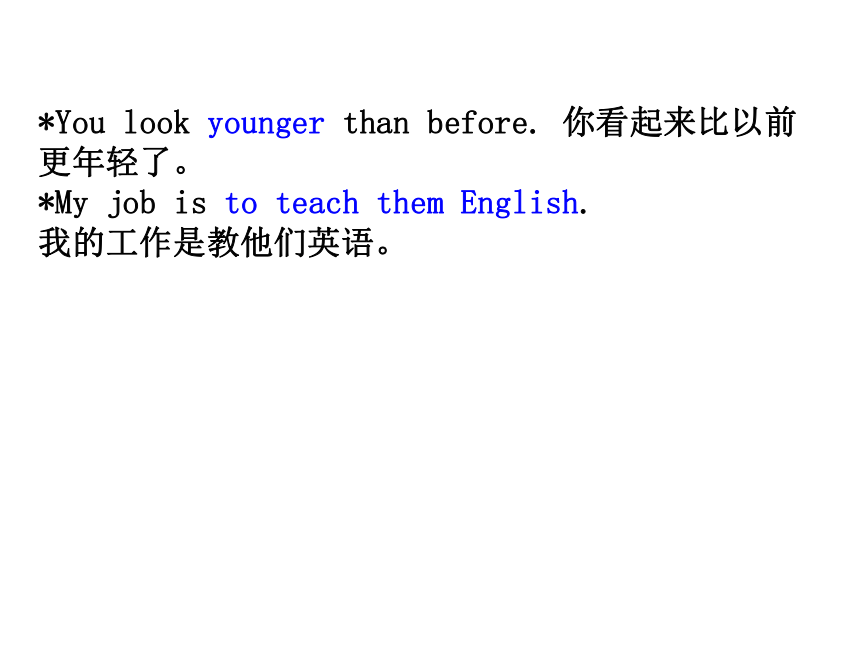
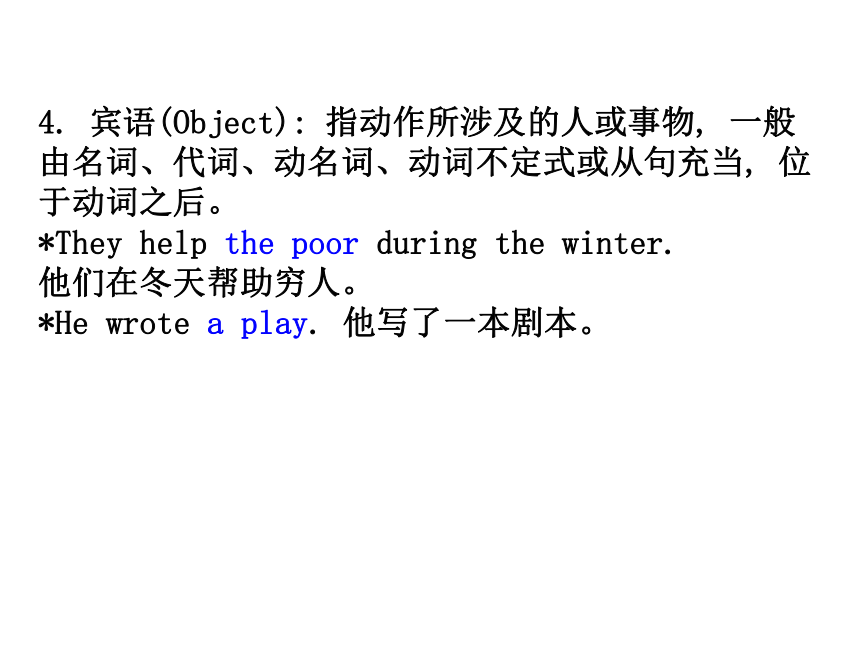
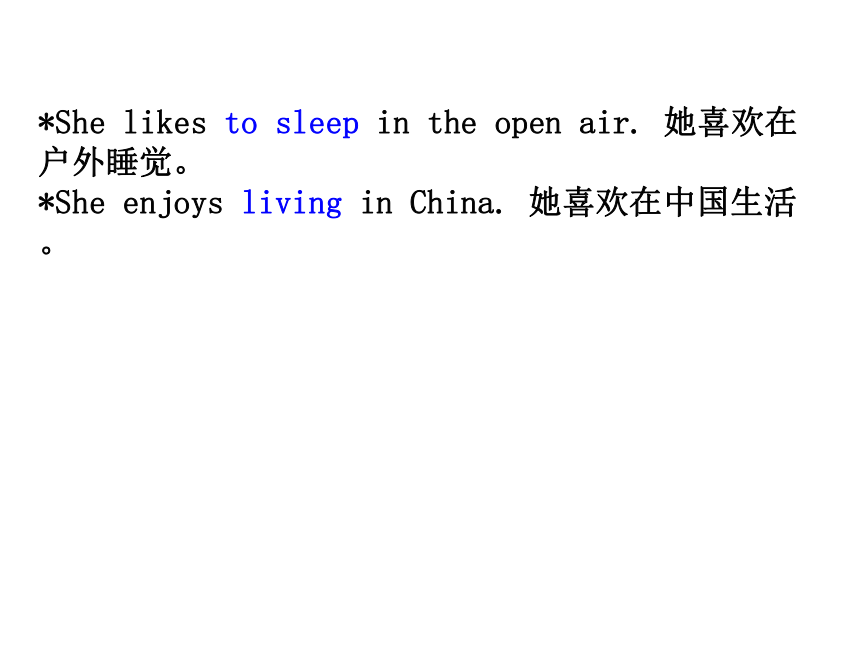
文档简介
课件43张PPT。
Welcome Unit
Discovering Useful Structures 基本句型(Basic sentence structures)
【情境探究】观察上面对话, 尝试完成下列句子:
(1) ____________in the east. ?
太阳在东方升起。
(2)She is _____________. ?
她是一个漂亮的女孩。
(3)We made ___________. 我们选他做班长。?The sun risesa beautiful girlhim monitor【要义详析】
一、句子的基本成分
根据英语词汇在英语句子中的地位和作用, 英语句子的成分可分为主语、谓语、宾语、宾语补足语、表语、定语、状语、同位语等。1. 主语(Subject): 表示句子所要说明或描述的人或事物, 一般由名词、代词、动名词、动词不定式或从句充当, 置于句首。
*I go to school by bus. 我乘公共汽车上学。
*The students are playing volleyball now.
现在学生们正在打排球。*To read in the sun is bad for your eyes.
在阳光下看书对你的眼睛有害。
*That you forgot to tell me the time for meeting caused me lots of trouble.
你忘了告诉我开会的时间, 给我惹了不少麻烦。2. 谓语(Verb): 说明或描述主语的动作、状态或特征, 由动词或动词短语充当, 位于主语之后。
*She likes drawing. 她喜欢绘画。
*I go to school at 8 a. m. on Mondays.
星期一上午八点我去上学。3. 表语(Predicative): 表示主语的身份、性质、状态和特征, 一般由名词、形容词、副词、介词短语、动名词、动词不定式或从句等充当。
常见的系动词有: be, become, appear, seem, look, sound, feel, get, smell等。
*I am a teacher. 我是一名教师。*You look younger than before. 你看起来比以前更年轻了。
*My job is to teach them English.
我的工作是教他们英语。4. 宾语(Object): 指动作所涉及的人或事物, 一般由名词、代词、动名词、动词不定式或从句充当, 位于动词之后。
*They help the poor during the winter.
他们在冬天帮助穷人。
*He wrote a play. 他写了一本剧本。*She likes to sleep in the open air. 她喜欢在户外睡觉。
*She enjoys living in China. 她喜欢在中国生活。【知识延伸】
直接宾语和间接宾语的区别: 直接宾语表示动作的承受者, 一般是物; 间接宾语表示动作是对谁或为谁做的, 一般是人。例如:
*Please show me your passport.
请把你的护照给我看一下。*Mother made Mary a new coat.
妈妈为玛丽做了一件新大衣。5. 宾语补足语(Object complement): 用来对宾语进行补充和说明, 一般由名词、非谓语动词、形容词等充当。
*He was allowed to go home. 他被允许回家。
*I saw you stand(ing) at the door. 我看见你站在门口。*I found it difficult to work out the math problem.
我发现计算出这道数学题很难。
*We call him Lao Li. 我们称他老李。【名师点津】两种结构中的宾语补足语形式
(1)“动词+形式宾语it+adj. /n. ”作宾语补足语, 常见的这类动词有: think, consider, feel, find, make。
(2)“感官动词+宾语+宾语补足语(省略to的不定式, v. -ing形式和过去分词)”: 当此结构用于被动语态时, 已省略的不定式符号to要还原。【知识延伸】
定语(attributive):
对名词或代词进行修饰、限制或说明, 一般由形容词、名词、代词、数词、介词短语、非谓语动词及从句等充当, 位置可在所修饰的词之前, 也可在所修饰的词之后。*The black schoolbag is mine. 黑色书包是我的。
*They made paper flowers. 他们做了纸花。
*The boys in the room are in Class Three Grade One. 房间里的男孩们是在一年级三班。
*I have something to tell you. 我有事情要告诉你。6. 状语(Adverbial): 用于修饰动词、形容词、副词、整个句子等, 一般由副词、介词短语、非谓语动词短语或从句等充当。
*He works very hard. 他工作很努力。
*She is lying in the bed thinking. 她躺在床上思考。【知识延伸】
同位语(appositive): 用于说明或解释之前的名词或代词的内容或情况, 其句法功能和它所修饰的名词或代词相同。同位语一般由名词、代词或句子等充当。
*We have two children, a boy and a girl.
我们有两个孩子, 一个男孩和一个女孩。【即学活用】
按照要求, 写出下列句子中的成分
(1)I enjoy helping others. (主语: _)
(2)My dream is possible! (表语: _______)
(3)All things are possible for me. (状语: ______) ?
(4)Do you have anything to say? (定语: _____)?Ipossiblefor meto say(5)We classmates work very hard. (同位语: _________)
(6)We should protect the environment. (宾语: ___
___________) ?
(7)No one can make me change my mind. (宾语补足语:
_______________) ?
(8)I always treat others with kindness. (谓语: _____)classmatestheenvironmentchange my mindtreat二、八种基本句型
1. SV (主语+谓语)
谓语动词为不及物动词, 不跟宾语, 但可以跟时间、地点、方式等状语, 常见的动词(词组)有sleep, walk, swim, happen(take place), go, come, work, laugh, stay, arrive, rise, rain, run, fly等。*(2019·全国卷Ⅰ)All the football players on the playground cheered loudly.
在操场上的所有足球选手都大声欢呼起来。
*They laughed. 他们大笑。2. SVO (主语+谓语+宾语)
谓语动词均为及物动词, 常见的动词有like, love, want, stop, hope, help, refuse, finish, eat, have, appreciate, water, make等。*(2019·浙江高考)Some very good schools don’t have a uniform policy.
有些好的学校没有校服政策。
*We should help the old and the poor.
我们应当帮助老人和穷人。
*I enjoy working with you. 我喜欢和你一起工作。*I hope to see you again. 我希望再次见到你。3. SP (主语+系动词+表语)
谓语动词均为系动词, 常见的系动词有: be, keep, look, feel, smell, sound, taste, grow, get, go, turn, become, seem, appear等。*(2019·浙江高考)School uniforms are traditional in Britain. 在英国校服是传统的。
*Tom looks thin. 汤姆看起来瘦。
*The food smells delicious. 这食物闻起来很香。4. SVIO DO (主语+谓语+间接宾语+直接宾语)
通常情况下, 间接宾语(通常指人)位于直接宾语(通常指物)的前面, 但有时根据需要, 间接宾语位于直接宾语之后, 这时要在间接宾语前加to或for。常用于该句型的动词有give, show, send, bring, read, pass, lend, leave, hand, tell, return, write, throw, make, buy, do, get, order, sing, pay 等。*I gave her a present. =I gave a present to her. 我给了她一件礼物。
*I bought him a pen. =I bought a pen for him. 我给他买了一支钢笔。5. SVOC (主语+谓语+宾语+宾语补足语)
宾语补足语部分可以为形容词、名词、非谓语动词等形式。 常用于该句型的动词(短语)有call, name, make, think, find, leave, see, watch, look at, listen to, hear, feel, let, have, get, keep, allow, need, want, ask等。其中宾语与宾语补足语统称为复合宾语。*We call him Jack. 我们叫他杰克。
*I found the movie interesting.
我觉得这部电影很有意思。
*They asked me to help them. 他们让我帮助他们。6. SVA (主语+谓语+状语)
*The children stayed in the room.
孩子们待在房间里。
*He runs slowly in the park every day.
每天他在公园里慢跑。7. SVOA (主语+谓语+宾语+状语)
*You can put the plate here. 你能把盘子放在这儿。
*He speaks English very well. 他英语说得非常好。8. There be. . . (there+系动词. . . )
There be后面的名词是句子的主语, 属倒装结构, 且系动词除be外, 还有: lie, stand, used to be, seem to be, appear to be 等。*There is a book and two cups on the table. 桌子上有一本书和两个杯子。
*There are some apples in the bowl. 碗里有一些苹果。【名师点津】There be句型的就近原则
There be句型中的be 动词的形式应和其后紧挨着的主语一致, 即“就近原则”。
句型中动词be可以为一般现在时、一般过去时、将来时和完成时。【即学活用】用给出的句型翻译下列句子
(1)会议九点开始。(S+V)
________________________?
(2)他们喜欢听古典音乐。(S+V+O)
___________________________________?The meeting begins at nine.They enjoy listening to the classic music.(3)天气渐渐冷了。(S+P)
___________________________
(4)我下次把那本书给你带来。(S+V+IO+DO)
_______________________________?It is getting colder and colder. ?I will bring you the book next time.(5)他听见一个女人在那边哭。(S+V+O+C)
____________________________________?
(6)今年, 我们这里已经有好几所私立学校了。(There
be)
____________________________________________
_________He heard a woman crying/cry over there.There have been several private schools in our areathis year. ?
Welcome Unit
Discovering Useful Structures 基本句型(Basic sentence structures)
【情境探究】观察上面对话, 尝试完成下列句子:
(1) ____________in the east. ?
太阳在东方升起。
(2)She is _____________. ?
她是一个漂亮的女孩。
(3)We made ___________. 我们选他做班长。?The sun risesa beautiful girlhim monitor【要义详析】
一、句子的基本成分
根据英语词汇在英语句子中的地位和作用, 英语句子的成分可分为主语、谓语、宾语、宾语补足语、表语、定语、状语、同位语等。1. 主语(Subject): 表示句子所要说明或描述的人或事物, 一般由名词、代词、动名词、动词不定式或从句充当, 置于句首。
*I go to school by bus. 我乘公共汽车上学。
*The students are playing volleyball now.
现在学生们正在打排球。*To read in the sun is bad for your eyes.
在阳光下看书对你的眼睛有害。
*That you forgot to tell me the time for meeting caused me lots of trouble.
你忘了告诉我开会的时间, 给我惹了不少麻烦。2. 谓语(Verb): 说明或描述主语的动作、状态或特征, 由动词或动词短语充当, 位于主语之后。
*She likes drawing. 她喜欢绘画。
*I go to school at 8 a. m. on Mondays.
星期一上午八点我去上学。3. 表语(Predicative): 表示主语的身份、性质、状态和特征, 一般由名词、形容词、副词、介词短语、动名词、动词不定式或从句等充当。
常见的系动词有: be, become, appear, seem, look, sound, feel, get, smell等。
*I am a teacher. 我是一名教师。*You look younger than before. 你看起来比以前更年轻了。
*My job is to teach them English.
我的工作是教他们英语。4. 宾语(Object): 指动作所涉及的人或事物, 一般由名词、代词、动名词、动词不定式或从句充当, 位于动词之后。
*They help the poor during the winter.
他们在冬天帮助穷人。
*He wrote a play. 他写了一本剧本。*She likes to sleep in the open air. 她喜欢在户外睡觉。
*She enjoys living in China. 她喜欢在中国生活。【知识延伸】
直接宾语和间接宾语的区别: 直接宾语表示动作的承受者, 一般是物; 间接宾语表示动作是对谁或为谁做的, 一般是人。例如:
*Please show me your passport.
请把你的护照给我看一下。*Mother made Mary a new coat.
妈妈为玛丽做了一件新大衣。5. 宾语补足语(Object complement): 用来对宾语进行补充和说明, 一般由名词、非谓语动词、形容词等充当。
*He was allowed to go home. 他被允许回家。
*I saw you stand(ing) at the door. 我看见你站在门口。*I found it difficult to work out the math problem.
我发现计算出这道数学题很难。
*We call him Lao Li. 我们称他老李。【名师点津】两种结构中的宾语补足语形式
(1)“动词+形式宾语it+adj. /n. ”作宾语补足语, 常见的这类动词有: think, consider, feel, find, make。
(2)“感官动词+宾语+宾语补足语(省略to的不定式, v. -ing形式和过去分词)”: 当此结构用于被动语态时, 已省略的不定式符号to要还原。【知识延伸】
定语(attributive):
对名词或代词进行修饰、限制或说明, 一般由形容词、名词、代词、数词、介词短语、非谓语动词及从句等充当, 位置可在所修饰的词之前, 也可在所修饰的词之后。*The black schoolbag is mine. 黑色书包是我的。
*They made paper flowers. 他们做了纸花。
*The boys in the room are in Class Three Grade One. 房间里的男孩们是在一年级三班。
*I have something to tell you. 我有事情要告诉你。6. 状语(Adverbial): 用于修饰动词、形容词、副词、整个句子等, 一般由副词、介词短语、非谓语动词短语或从句等充当。
*He works very hard. 他工作很努力。
*She is lying in the bed thinking. 她躺在床上思考。【知识延伸】
同位语(appositive): 用于说明或解释之前的名词或代词的内容或情况, 其句法功能和它所修饰的名词或代词相同。同位语一般由名词、代词或句子等充当。
*We have two children, a boy and a girl.
我们有两个孩子, 一个男孩和一个女孩。【即学活用】
按照要求, 写出下列句子中的成分
(1)I enjoy helping others. (主语: _)
(2)My dream is possible! (表语: _______)
(3)All things are possible for me. (状语: ______) ?
(4)Do you have anything to say? (定语: _____)?Ipossiblefor meto say(5)We classmates work very hard. (同位语: _________)
(6)We should protect the environment. (宾语: ___
___________) ?
(7)No one can make me change my mind. (宾语补足语:
_______________) ?
(8)I always treat others with kindness. (谓语: _____)classmatestheenvironmentchange my mindtreat二、八种基本句型
1. SV (主语+谓语)
谓语动词为不及物动词, 不跟宾语, 但可以跟时间、地点、方式等状语, 常见的动词(词组)有sleep, walk, swim, happen(take place), go, come, work, laugh, stay, arrive, rise, rain, run, fly等。*(2019·全国卷Ⅰ)All the football players on the playground cheered loudly.
在操场上的所有足球选手都大声欢呼起来。
*They laughed. 他们大笑。2. SVO (主语+谓语+宾语)
谓语动词均为及物动词, 常见的动词有like, love, want, stop, hope, help, refuse, finish, eat, have, appreciate, water, make等。*(2019·浙江高考)Some very good schools don’t have a uniform policy.
有些好的学校没有校服政策。
*We should help the old and the poor.
我们应当帮助老人和穷人。
*I enjoy working with you. 我喜欢和你一起工作。*I hope to see you again. 我希望再次见到你。3. SP (主语+系动词+表语)
谓语动词均为系动词, 常见的系动词有: be, keep, look, feel, smell, sound, taste, grow, get, go, turn, become, seem, appear等。*(2019·浙江高考)School uniforms are traditional in Britain. 在英国校服是传统的。
*Tom looks thin. 汤姆看起来瘦。
*The food smells delicious. 这食物闻起来很香。4. SVIO DO (主语+谓语+间接宾语+直接宾语)
通常情况下, 间接宾语(通常指人)位于直接宾语(通常指物)的前面, 但有时根据需要, 间接宾语位于直接宾语之后, 这时要在间接宾语前加to或for。常用于该句型的动词有give, show, send, bring, read, pass, lend, leave, hand, tell, return, write, throw, make, buy, do, get, order, sing, pay 等。*I gave her a present. =I gave a present to her. 我给了她一件礼物。
*I bought him a pen. =I bought a pen for him. 我给他买了一支钢笔。5. SVOC (主语+谓语+宾语+宾语补足语)
宾语补足语部分可以为形容词、名词、非谓语动词等形式。 常用于该句型的动词(短语)有call, name, make, think, find, leave, see, watch, look at, listen to, hear, feel, let, have, get, keep, allow, need, want, ask等。其中宾语与宾语补足语统称为复合宾语。*We call him Jack. 我们叫他杰克。
*I found the movie interesting.
我觉得这部电影很有意思。
*They asked me to help them. 他们让我帮助他们。6. SVA (主语+谓语+状语)
*The children stayed in the room.
孩子们待在房间里。
*He runs slowly in the park every day.
每天他在公园里慢跑。7. SVOA (主语+谓语+宾语+状语)
*You can put the plate here. 你能把盘子放在这儿。
*He speaks English very well. 他英语说得非常好。8. There be. . . (there+系动词. . . )
There be后面的名词是句子的主语, 属倒装结构, 且系动词除be外, 还有: lie, stand, used to be, seem to be, appear to be 等。*There is a book and two cups on the table. 桌子上有一本书和两个杯子。
*There are some apples in the bowl. 碗里有一些苹果。【名师点津】There be句型的就近原则
There be句型中的be 动词的形式应和其后紧挨着的主语一致, 即“就近原则”。
句型中动词be可以为一般现在时、一般过去时、将来时和完成时。【即学活用】用给出的句型翻译下列句子
(1)会议九点开始。(S+V)
________________________?
(2)他们喜欢听古典音乐。(S+V+O)
___________________________________?The meeting begins at nine.They enjoy listening to the classic music.(3)天气渐渐冷了。(S+P)
___________________________
(4)我下次把那本书给你带来。(S+V+IO+DO)
_______________________________?It is getting colder and colder. ?I will bring you the book next time.(5)他听见一个女人在那边哭。(S+V+O+C)
____________________________________?
(6)今年, 我们这里已经有好几所私立学校了。(There
be)
____________________________________________
_________He heard a woman crying/cry over there.There have been several private schools in our areathis year. ?
